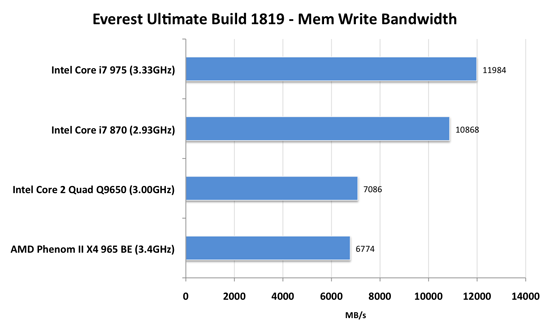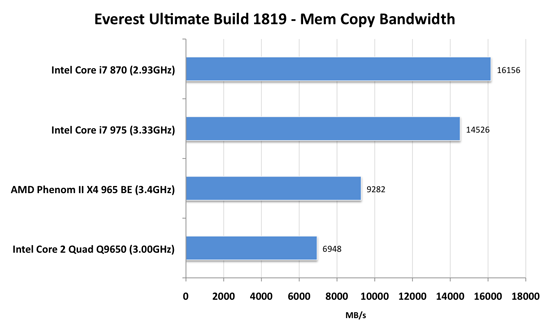Intel's Core i7 870 & i5 750, Lynnfield: Harder, Better, Faster Stronger
by Anand Lal Shimpi on September 8, 2009 12:00 AM EST- Posted in
- CPUs
Discovery: Two Channels Aren't Worse Than Three
Intel told me something interesting when I was out in LA earlier this summer: it takes at least 3 cores to fully saturate Lynnfield's dual-channel DDR3-1333 memory bus. That's three cores all working on memory bandwidth intensive threads at the same time. That's a pretty stiff requirement. In the vast, vast majority of situations Lynnfield's dual channel DDR3 memory controller won't hurt it.
Move up to 6 or 8 core designs and a third memory channel is necessary, and that's why we'll see those processors debut exclusively on LGA-1366 platforms. In fact, X58 motherboards will only need a BIOS update to work with the 6-core 32nm Gulftown processor next year. P55 looks like it'll be limited to four cores and below.
Because of this, Lynnfield's memory bandwidth and latency cores are actually quite similar to Bloomfield. I used Everest to look at memory bandwidth and latency between a Core i7 975 and Core i7 870 (Lynnfield):

Lynnfield's memory controller is good, easily as good as what's in Bloomfield if not slightly better.



Both processors turbo'd up to 3.46GHz, indicating that Everest's memory test uses no more than two threads. The 975 ran DDR3-1066 memory (the highest it officially supports), while the 870 used DDR3-1333. The faster memory gave the 870 the advantage. Since we're not taxing all four cores, Lynnfield is at no disadvantage from a bandwidth perspective. Surprisingly enough, even SiSoft Sandra (which does use four cores for its memory bandwidth test) shows Lynnfield's dual-channel DDR3-1333 memory controller as equal to Bloomfield's triple-channel DDR3-1066 interface.
| SiSoft Sandra 2009.SP4 | Intel Core i7 975 | Intel Core i7 870 |
| Aggregate Memory Bandwidth | 17.8 GB/s | 17.3 GB/s |
Long story short? Lynnfield won't be memory bandwidth limited with DDR3-1333 for the overwhelming majority of usage cases.










343 Comments
View All Comments
jnr0077 - Thursday, July 26, 2012 - link
well i have the better model i5 750 1156 socket gaming score is 5.9 on basic 500 gb hd 7200 with a ssd it hit 7.9 on a gigabyte GA-P55A-UD6 12gb ram. as for the pricecost was cheep intel (R)quad core (TM) i5 750 @2.66 GHz 2.67GHz cost around £100 mobo cost me £100 i though it is a very cheep upgrade considering price i wood like to here what score any Pehnom II X4 965 hit
Milleman - Sunday, September 13, 2009 - link
The article itself is good. But Why on earth compare a standard clocked CPU (AMD) against overclocked ones (Intel). Makes no objective sense att all. I's like having a car test between a standard car and a tuned racecar. Of course the racecar will win in performance. The overclock results shouldn't be there at all. Maybe as a remark that tell what will happen if one would like to overclock. Looks rather unfair and biased.So... why??
Nich0 - Sunday, September 13, 2009 - link
All I saw in this article is comparison of CPUs in their stock configuration. What's wrong with that?Bozo Galora - Friday, September 11, 2009 - link
I must say this was a very good logical coherent review with just about all the info one would requireGood job - I had no intention of getting one of these, but now I may change my mind
IntelUser2000 - Thursday, September 10, 2009 - link
http://www.intel.com/support/processors/sb/CS-0299...">http://www.intel.com/support/processors/sb/CS-0299...According to Intel...
Core i7 870:
5/4/2/2
Core i7 860:
5/4/1/1/
Core i5 750:
4/4/1/1
So the i7 870 has higher Turbo mode for 3 and 4 cores than 860 does.
Nich0 - Friday, September 11, 2009 - link
Yeah and that means that the OC numbers for the 750 with Turbo don't make sense. For example 4160 / 160 = 26 which would be a Turbo of 6 BCLK.Same thing for the 860 OC 3C/4C Turbo number.
Am I missing something?
IntelUser2000 - Friday, September 11, 2009 - link
Its likely Anand has ES versions or such which allows multiplier adjustments. But at stock, the linked speeds are the Turbo Boost grades.Nich0 - Friday, September 11, 2009 - link
Yeah obviously I am not disputing the stock OC with Turbo enabled (that sounds weird: stock OC?), ie 160*20= 3200, but just what it means in terms of Turbo: it 'should' read 3.36 for 3/4C and 3.84 for 1/2C if the 1/1/4/4 Turbo spec is correct.rdkone - Thursday, September 10, 2009 - link
I don't like the fact that the BCLK directly and synchronously communicates with PCIe buss, thus affecting the videocard negatively (among other PCIe cards)... This is like overclocking years ago whereas the PCI bus would be affected in the same way and causing headaches... This is a major issue I feel for those wanting to push a fairly big overclock on these CPU's... Intel screwed the pooch for us overclockers I feel... Just more justification to limp along with my core 2 quad at 4.1Ghz rock solid... Like others have said, is funny how the articles don't show older CPU overclocks against all this new garb... In the past they used to... But that hurts sales : )SnowleopardPC - Thursday, September 10, 2009 - link
Ok, so what type of boost do I get over a Q6600 with 8gb of ram and windows 7 64?Is it worth upgrading or waiting for that 6 core 32nm to come out next year?
To upgrade to any of these I will need to replace a motherboard and ram with the processor.